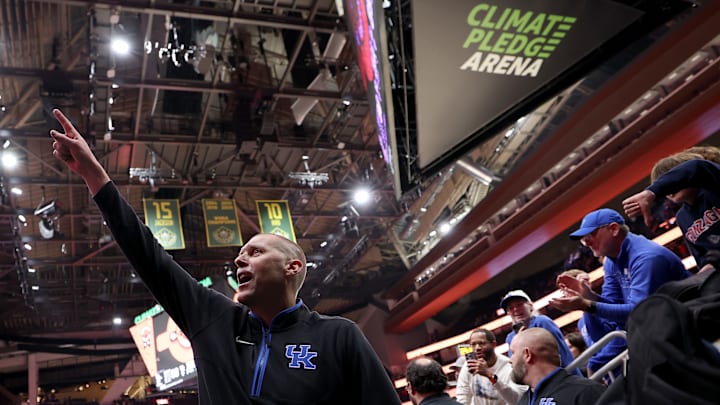Once again, the Kentucky Wildcats went into a huge arena against a top-10 opponent and struggled through the first half. They did it first against Duke and then had an even bigger first-half struggle against Gonzaga. Yet, both times, the Wildcats came out with the victory. Mark Pope knows how to make adjustments at half-time to get the most out of his team. He knows what buttons to push to get the most out of his team, and it has worked marvelously against the best of the best in terms of competition.
Master class of coaching by Mark Pope
— Matt Jones (@KySportsRadio) December 8, 2024
And what a tough victory by this team!!!!!
What exactly did Mark Pope do to make such a big swing? They were down 16 at the half and yet won. They allowed the Zags to score 50 in the first half and only 29 in the second. They scored only 34 in the first half but 45 in the second. What led to such a big turnaround? Here are the five things that Mark Pope did:
1. Defensive assignments in man
In the first half, Ryan Nembhard, arguably the best point guard in the nation with a 10/1 assist-to-turnover ratio, was dicing Kentucky up. He was getting any look he wanted and taking over the game, setting up his teammates (especially Graham Ike) without much resistance from Kentucky.
In the second half, Pope switched who was guarding who when they were in man. Pope put Otega Oweh on Nembhard and moved Kriisa to Nolan Hickman. When Oweh was on the bench, Jaxson Robinson was guarding Nembhard. This disrupted the Gonzaga offense in so many ways. Oweh did not let Nembhard settle in and was a nuisance on defense.
2. Zone and morph zone looks
The one that is being talked about a lot is Mark Pope's defensive adjustments. He was trying to throw Gonzaga out of rhythm not just from who was guarding who but even giving the Zags different looks. He mixed in 1-3-1 zone at times and even what he called a "morph zone," which was a zone look but a man-to-man switch. It also morphed the other way at times too. It was disorienting for Gonzaga, and they couldn't find their offensive rhythm.
3. Rebounding with tips
Kentucky was noticeably different on the glass from one half to the other. In the first half, Gonzaga out-rebounded Kentucky 25-16. At the end of the game, Kentucky outrebounded Gonzaga 43-42. That's a huge swing for both teams. The Wildcats had a 27-17 rebound margin in the second half. That's a literal reversal.
How did this happen? It was mostly done through positioning and aggression. We will get to the other one in a minute, but the positioning was key. They were able to get into better spots than they did in the first half. Then, if they weren't able to secure the rebound, they started tipping it out. This was game-changing, even getting guards in the mix to pull down rebounds.
4. Letting Carr eat
Carr was a machine all night, but it was the second-half surge in the paint that helped Kentucky mightily on the offensive side of the ball. In the first half, Carr had 6 points and 3 rebounds. He ended the game with 19 points and 7 rebounds. He took over in a mighty way on the scoring effort. Pope was finding ways to feed him the ball and let him go to work.
5. Aggression on every possession
Finally, Mark Pope pushed his players to be more aggressive. The broadcast talked about how, before the game, Pope told his players that if they didn't want to rebound against Gonzaga, they might as well just go home. What Pope said during half-time hasn't been released, but he spurred something in them to be more aggressive. As mentioned above, they were tipping rebounds, guards were even fighting bigs in the paint, bodies were diving to the floor for balls. Kentucky was soft in the first half but aggressive in the second, which was a major key to victory.
These are the five keys that Pope put into the lock. When he turned, the Wildcats were able to beat Gonzaga in overtime, overcoming a 16-point half-time deficit.
